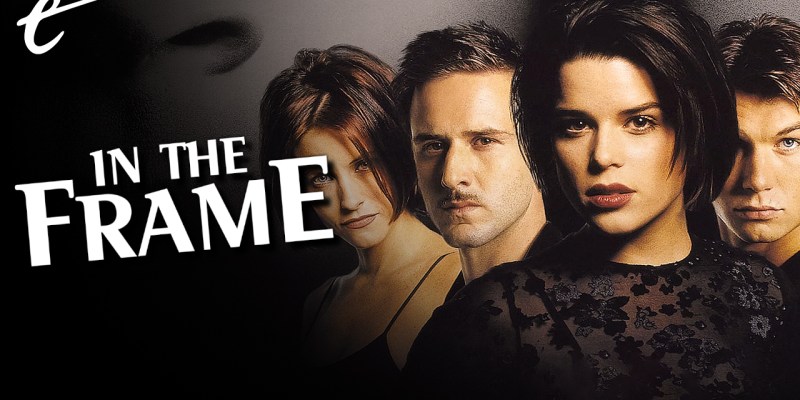“Sequels suck!” Randy Meeks (Jamie Kennedy) boldly declares early in Scream 2. “By definition alone, sequels are inferior films!” It is a bold statement, particularly in the context of a rushed sequel to a horror movie that had been greeted as “a bravura, provocative sendup of horror pictures” that essentially resurrected the slasher film as a credible subgenre. “The genre was dying and Scream saved it,” argued Night of the Living Dead director George Romero in November 1997.
A sequel was a daunting prospect. Scream 2 had a turbulent production. Miramax rushed the film to get it into cinemas less than a year after the original became an unlikely breakout hit. Screenwriter Kevin Williamson found himself in great demand, writing I Know What You Did Last Summer that released a few months before Scream 2, while working on the stories for the following year’s Halloween H20 and The Faculty. It seems fair to suggest that his attention might have been split.
Scream 2 was beset with leaks. Williamson would email script pages to director Wes Craven, only for those pages to end up on the internet that night. Extras smuggled video cameras into the filming of the movie’s opening scene, and it quickly circulated online. Even operating on the film’s tight schedule, there were constant reshoots. While Williamson disputes the oft-repeated rumor that the identity of the killer was changed in response to leaks, it was nevertheless a chaotic and rushed production.
As such, it is a surprise that Scream 2 is at all coherent. It’s even more impressive that the film is a slasher masterpiece. Understandably overshadowed by the genre-resurrecting movie that preceded it, Scream 2 is the perfect sequel. It may even be the best slasher sequel ever made. It does what great sequels do — it engages with the movie that came before, escalating the stakes and diving deeper into the themes. Scream 2 doubles down on everything that helped Scream become a classic.
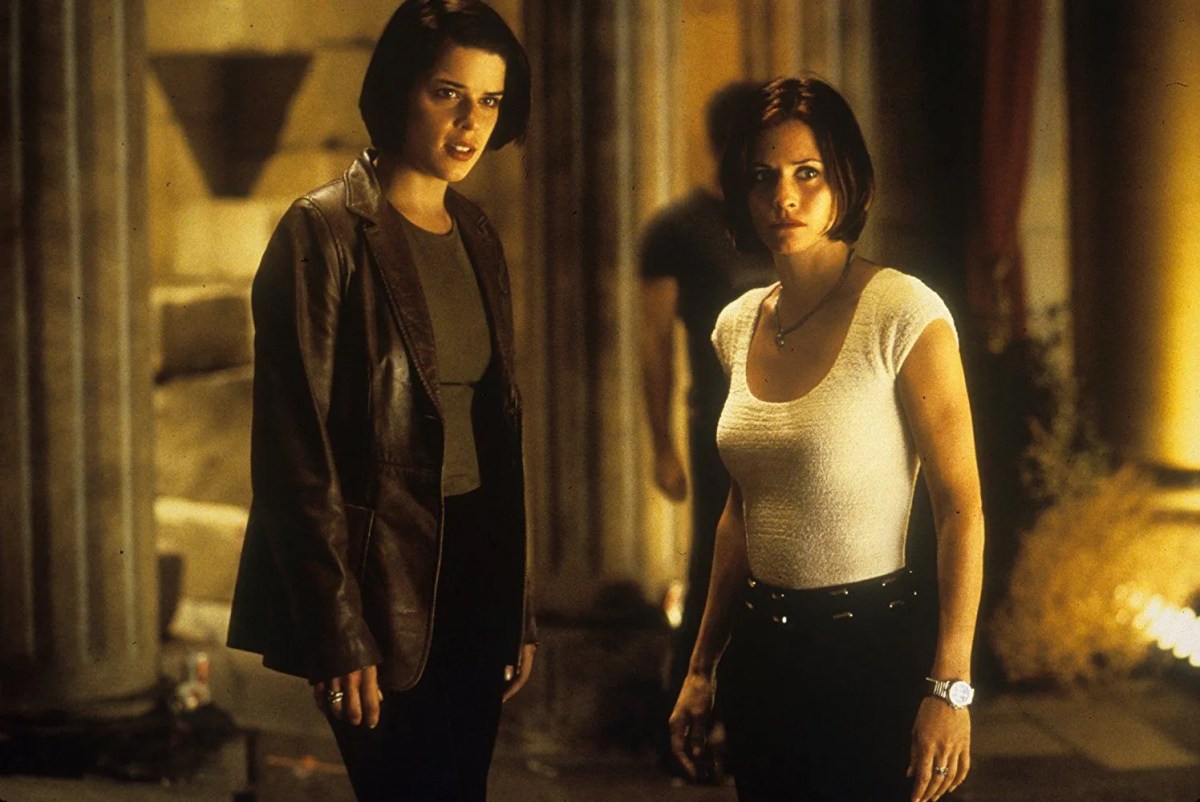
Scream is often discussed as a postmodern and self-aware horror. After all, it is a horror movie that is acutely aware of the rules that govern horror movies. While Randy is the most obvious example of this — a video store clerk who can wax rhapsodical on the conventions of the genre — all of the teenage characters in Scream are conversant in pop culture. This is especially true of the killers, Billy Loomis (Skeet Ulrich) and Stu Macher (Matthew Lillard), who quiz their victims on horror movie trivia.
However, part of the appeal of Scream lay in the fact that it was also a really good example of the genre. It played with various tropes, even winkingly subverting a couple, but also hit all of its marks. In contrast, Scream 2 leans more heavily into the franchise’s exploration of horror movie tropes, to the point that these discussions become quite literally academic. In Scream, Randy lectures drunken schoolmates at a house party. In Scream 2, he argues with fellow film students in a classroom at Windsor College.
Scream 2 draws attention to its artifice. One of the killers, Mickey Altieri (Timothy Olyphant), is described as “the freaky Tarantino film student.” In the world of Scream 2, everything is mediated. Mickey is constantly seen holding a video camera and later plays footage of his crimes. Scream 2’s opening scene takes place at a sneak preview of Stab, a film based on the events of the first film. The footage from Stab is directed by Robert Rodriguez and stars Heather Graham, Tori Spelling, and Luke Wilson.
In the hopes of identifying the killer in news footage from reports at the crime scenes, Gale Weathers (Courteney Cox) and Dewey Riley (David Arquette) visit the School of Film, where they are menaced by the Ghostface killer. The film’s grand finale takes place on a theater stage, where Sidney Prescott (Neve Campbell) has been rehearsing her role as Cassandra in Aeschylus’ Agamemnon. She overwhelms the other killer, Nancy Loomis (Laurie Metcalf), by working the set mechanics, recreating the play’s climax.
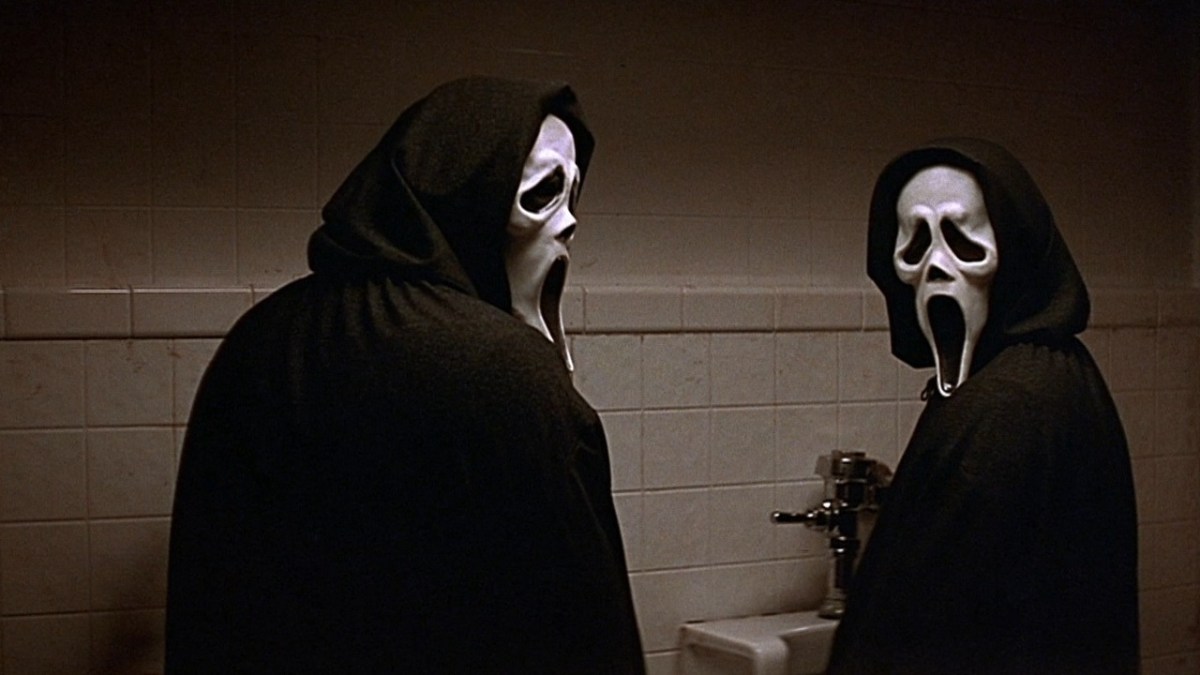
If Scream was a love letter to the slasher movie, Scream 2 is more cynical. Randy and Mickey argue over the quality of sequels, a scene used in promotional campaigns for the movie. Scream 2 opens with Maureen Evans (Jada Pinkett Smith) criticizing the whiteness of the genre, years before that debate went mainstream. Gail’s cameraman Joel (Duane Martin) complains that “brothers don’t last long in situations like this,” beating Evolution to a punchline by a couple of years, even if Canadian Bacon got there even earlier.
What little the audience sees of Stab is decidedly lurid. The opening scene of Scream is one of the best opening scenes in cinema history, a masterclass in suspense as Casey Becker (Drew Barrymore) is menaced over the phone. Stab leans into the worst impulses of trashy horror, having Heather Graham strip down and get naked as the audience hollers. “Now, why has she got to be naked?” Maureen asks. “What does that have to do with the plot of the story, her being butt-ass naked?”
Scream 2 doesn’t seem to hold a high opinion of its audience and their voyeuristic impulses. Maureen’s boyfriend Phil Stevens (Omar Epps) is killed trying to eavesdrop on an argument in the next toilet stall. Maureen herself is murdered in a crowded auditorium. She stumbles onto the stage, covered in blood. The moviegoers cheer as she keels over. “Three hundred people watched,” Sidney explains. “Nobody did anything. They thought it was a publicity stunt, for Christ’s sake.” Randy deadpans, “And it would have been a good one too.”
Scream 2 begins the franchise’s earnest engagement with celebrity culture. Everybody in Scream 2 hopes to profit from the carnage. Gale is a bestselling author, a reporter who finds herself “on the other side of the news.” Cotton Weary (Liev Schreiber) has been released from prison after he was framed for killing Sidney’s mother. He hopes to reinvent himself as a celebrity. “You promised me ten minutes of national coverage,” he chides Gale. He literally wants his “fifteen minutes.”
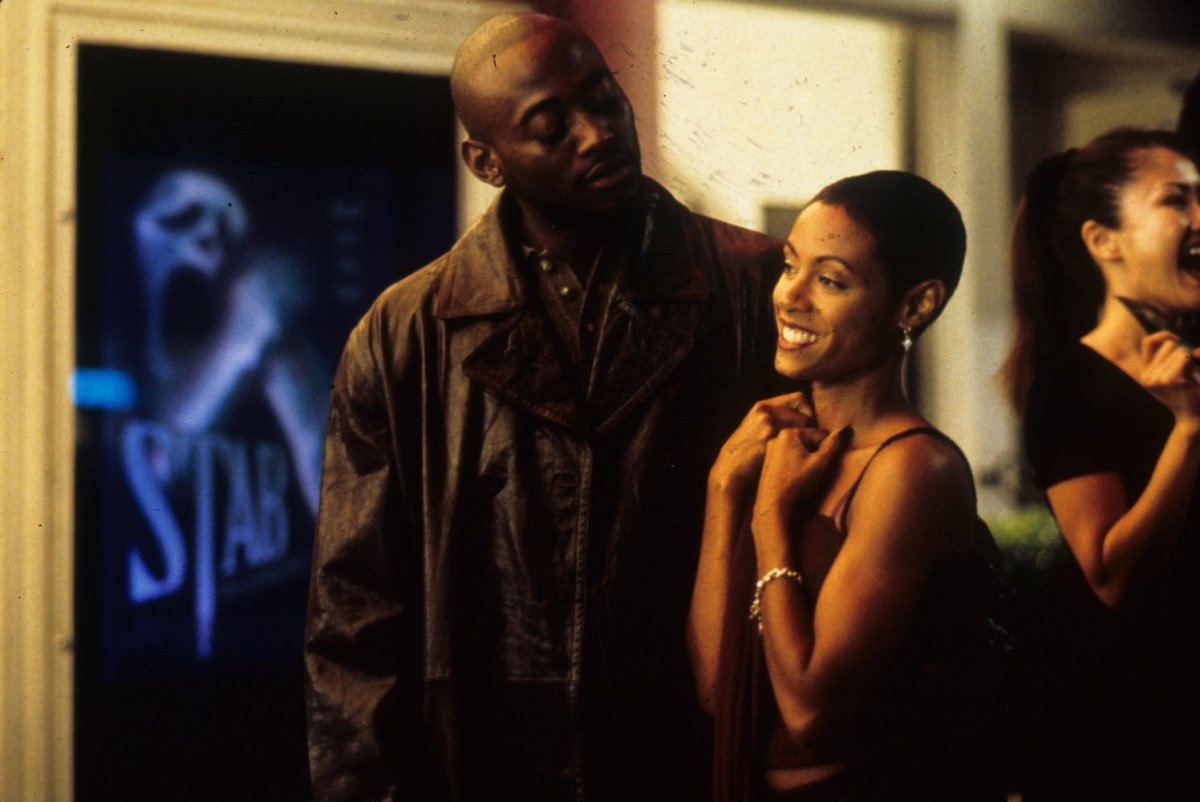
The shadow of the OJ Simpson trial and the resulting media circus looms over Scream 2. Mickey even namedrops Johnnie Cochran and Alan Dershowitz during his motive rant. In another scene, he references both Jeffrey Dahmer and Tom Cruise. Mickey wants to be famous, to be at the center of a public spectacle. With Nancy holding a knife to her neck, Sidney convinces Cotton to save her by agreeing to a joint interview with Diane Sawyer. It’s a literal cutthroat negotiation.
There’s a haunting sense of emptiness to all this. Violence is just another commodity to be packaged and sold, a way to leverage fame and celebrity. Mickey dies before he can follow through on his plan, but the movie ends with Cotton handing out business cards to reporters. He is the hero of the story, but one who only saved Sidney to advance his own public profile. Sidney wanders off, away from the media. The camera pulls up, losing her in the college’s open space. It’s a directorial choice that affords Sidney some privacy and dignity.
In some ways, Scream 2 takes the postmodern elements of Scream and amplifies them to the point that they become horrific. Billy referenced horror movies during his rampage in Scream, but his motivations were straightforward. They were rooted in the misogyny that drives so many slasher villains. Billy hated Sidney’s mother, blaming her for breaking up his parents’ marriage. That might be monstrous, but it is a human motivation. The motives of Mickey and Cotton are more abstracted.
However, this level of abstraction allows Scream 2 to more sharply focus on its human elements. Most horror franchises are built around returning villains: Michael Myers in the Halloween movies, Freddy Krueger in the Nightmare on Elm Street series, Pinhead in the Hellraiser movies. In contrast, while the killer in the Scream movies is always voiced by Roger L. Jackson, the killer’s identity always changes. There are often multiple killers. It is final girl Sidney that anchors the Scream series.
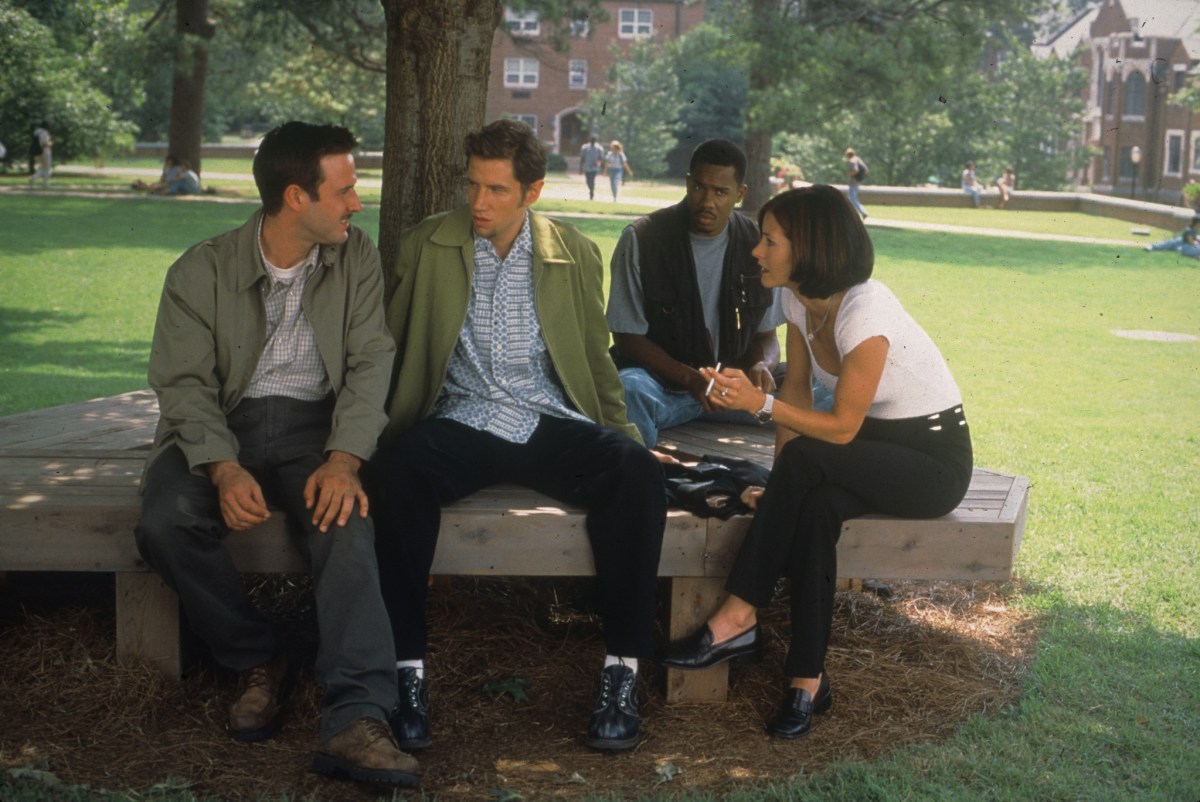
It’s cliché to suggest that modern horrors are about “trauma,” to the point that films like Nia DaCosta’s Candyman are movies about art about trauma. However, Scream 2 is about what it means to want to make a sequel to a slasher movie and the audience’s relationship to that. After all, the only reason to bring back a slasher survivor is to traumatize them all over again. Scream 2 cuts from Maureen’s horrific murder to Sidney getting prank phone calls purporting to be from “Ghostface.”
In the midst of all this postmodern self-awareness, Scream 2 never loses sight of what it means to force Sidney to relive this horror all over again. “Stop treating me like glass, Dewey,” she insists. “I’m not going to break.” She finds herself growing suspicious of her boyfriend Derek Feldman (Jerry O’Connell), worrying that he might betray her just like Billy did. Her life is caught in the gravity of the horror of Scream, and the existence of a sequel means that she must be traumatized again and again.
One of the film’s most overtly self-aware choices, which is saying something given the rest of the movie, is when Sidney is cast as Cassandra in Agamemnon. Craven apparently wrote that sequence largely himself, perhaps reflecting his master’s degree in writing and philosophy. This obviously frames Sidney’s story as a tragedy, as she monologues that “fate’s vengeful eye is fixed on (her).” It anchors Scream 2 in a very real humanity.
Indeed, Scream 2 ultimately rejects its postmodern trapping. Mickey is killed by Nancy, who ascribes to a more grounded and human motivation. “My motive isn’t as ’90s as Mickey’s,” she confesses. “Mine is just good old-fashioned revenge.” Nancy is Billy’s mother, a twist that takes Scream 2 all the way back to Pamela Voorhees (Betsy Palmer) from Friday the 13th, one of the films that really codified slashers as a grubby and trashy subgenre. When all else fails, go back to basics.
Randy knew as much. “Mrs. Voorhees was a terrific serial killer,” he assured Dewey earlier in the film. This is what makes Scream 2 such a brilliant sequel. It doubles down on the reflexiveness and self-awareness that made Scream so beloved, without losing sight of its humanity. When it comes to slasher sequels, Scream 2 is a cut above.
